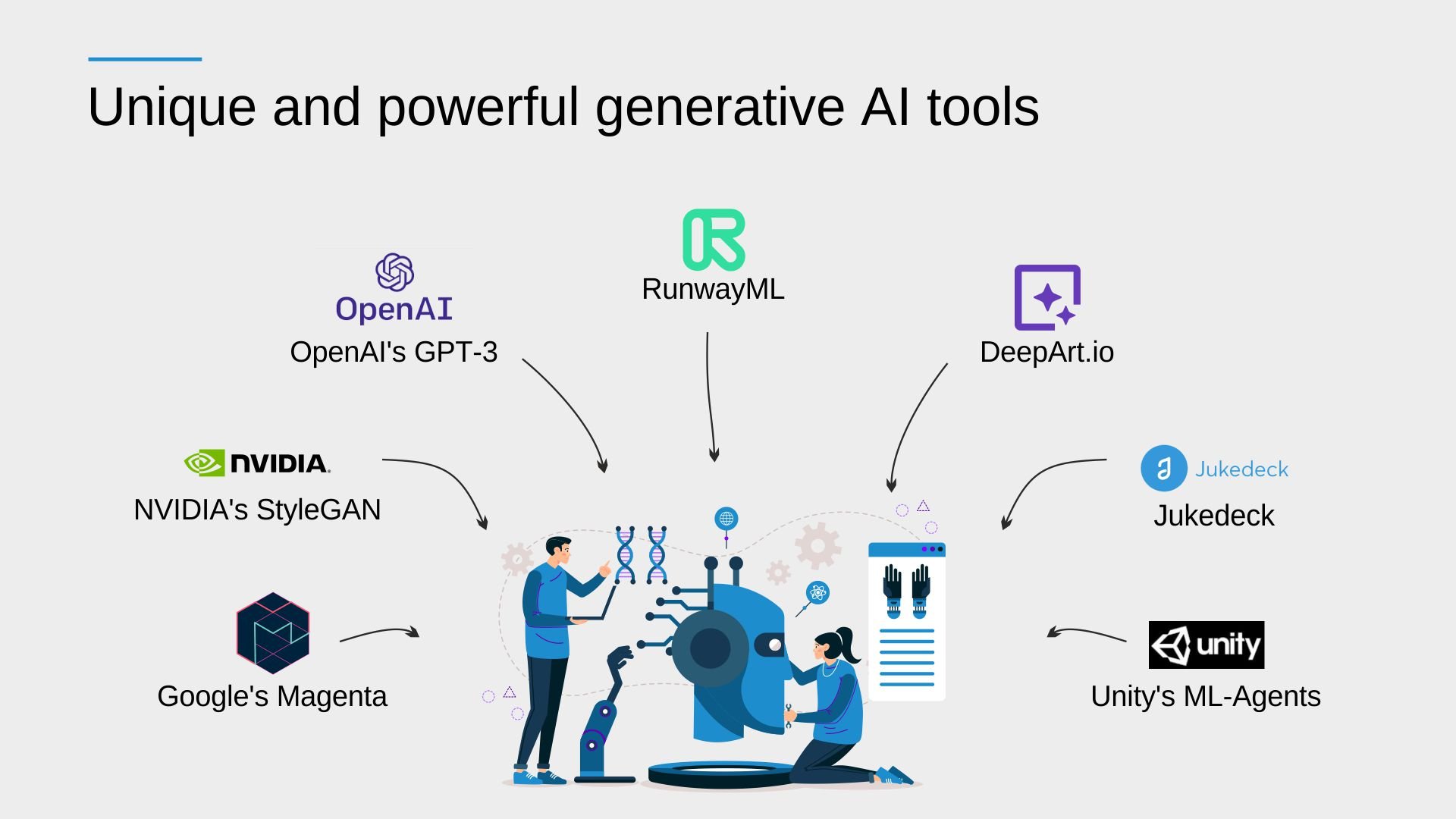Generative Artificial Intelligence (AI) tools have become essential for unleashing creative potential and driving innovation across various industries. These tools leverage advanced algorithms and models to generate original content, enabling users to create stunning artwork, compose music, design virtual worlds, and much more. In this blog, we will delve into a collection of unique and powerful generative AI tools that empower individuals and organizations to explore new creative horizons and revolutionize the way we think about content creation.

RunwayML
RunwayML is a versatile generative AI tool that provides a user-friendly interface for artists, designers, and developers. It offers a range of AI models, including style transfer, text-to-image generation, pose estimation, and more. With RunwayML, users can experiment with AI-generated content in real-time, enabling interactive and dynamic creative workflows. The tool facilitates easy integration with popular design software and frameworks, making it accessible to both beginners and experienced practitioners.
OpenAI's GPT-3
OpenAI's GPT-3 (Generative Pre-trained Transformer 3) has garnered significant attention for its impressive language generation capabilities. It can generate coherent and contextually relevant text, answer questions, translate languages, and even create conversational agents. GPT-3 has immense potential in content creation, chatbot development, and natural language processing tasks. Developers can leverage OpenAI's API to integrate GPT-3 into their applications and explore new avenues of human-machine interaction.
NVIDIA's StyleGAN
StyleGAN, developed by NVIDIA, is a powerful generative model that excels in image synthesis and editing. It has the ability to generate highly realistic and diverse images based on different input styles and attributes. StyleGAN has been used to create lifelike human faces, stunning landscapes, and even artwork in various styles. With its intuitive controls and impressive output quality, StyleGAN has become a go-to tool for artists, designers, and researchers looking to explore the possibilities of AI-generated visuals.
Google's Magenta
Magenta, an open-source project by Google, focuses on developing generative AI models for music composition and creativity. It offers a wide range of tools, libraries, and models that enable users to experiment with AI-generated music. From melody generation to harmonization and style transfer, Magenta provides a comprehensive toolkit for musicians, composers, and music enthusiasts. It aims to augment human creativity and explore the intersection of AI and music.
DeepArt.io
DeepArt.io is a popular generative AI tool that specializes in style transfer and artistic image generation. Users can upload their images and apply various artistic styles to transform them into unique and visually appealing compositions. DeepArt.io leverages deep neural networks to learn from famous art styles and apply them to user-submitted images. The tool offers a simple and intuitive interface, making it accessible to both professionals and amateurs in the art community.
Jukedeck
Jukedeck is an AI-powered music composition tool that enables users to create original music tracks effortlessly. By selecting genre, mood, and tempo, users can generate personalized music compositions tailored to their specific needs. Jukedeck's AI models analyze patterns and generate cohesive music pieces, making it a valuable tool for content creators, video producers, and advertisers seeking high-quality royalty-free music.
Unity's ML-Agents
Unity's ML-Agents is a framework that combines generative AI with game development, allowing developers to create intelligent virtual characters and NPCs. By leveraging reinforcement learning techniques, ML-Agents enable the training of AI-controlled agents within virtual environments. This opens up possibilities for interactive and adaptive gameplay experiences, where virtual characters learn and evolve based on user interactions.
Conclusion
Generative AI tools have become indispensable for fostering creativity, enabling users to generate unique content and explore new creative possibilities. From RunwayML's versatile interface to OpenAI's GPT-3's language generation prowess and NVIDIA's StyleGAN's impressive image synthesis capabilities, these tools empower artists, designers, musicians, and developers to push the boundaries of their respective fields. As generative AI continues to advance, we can expect even more innovative tools and applications that will shape the future of content creation and human-machine collaboration.
